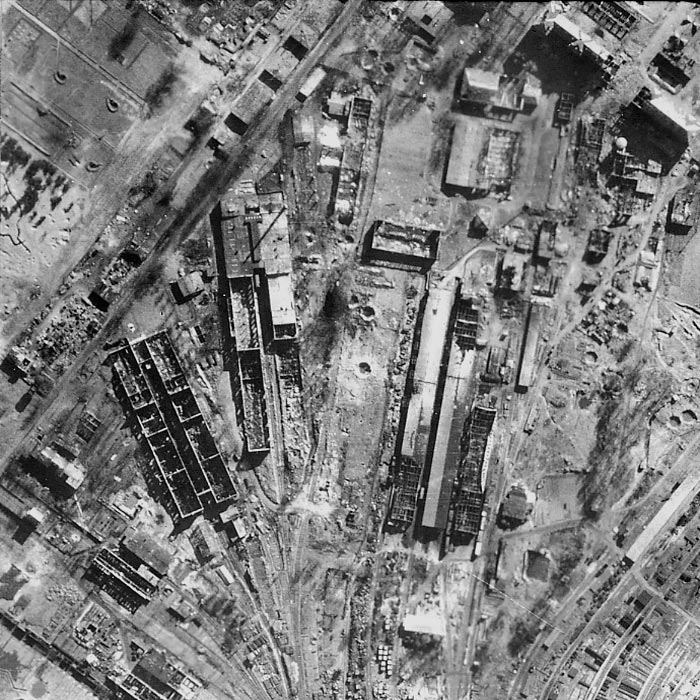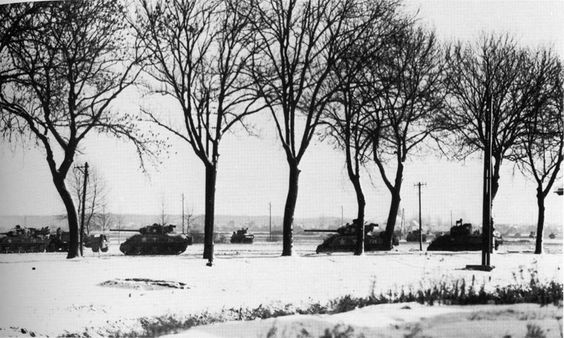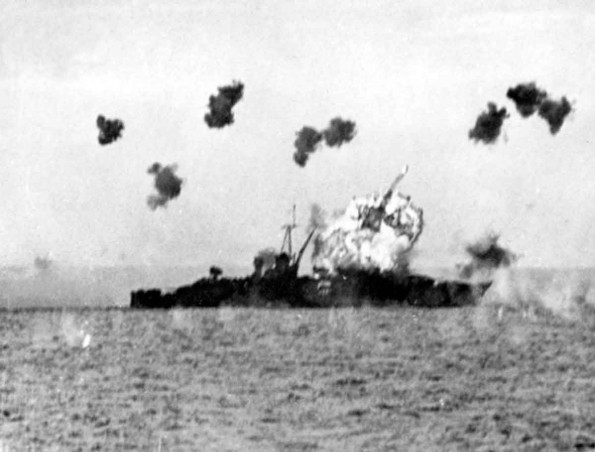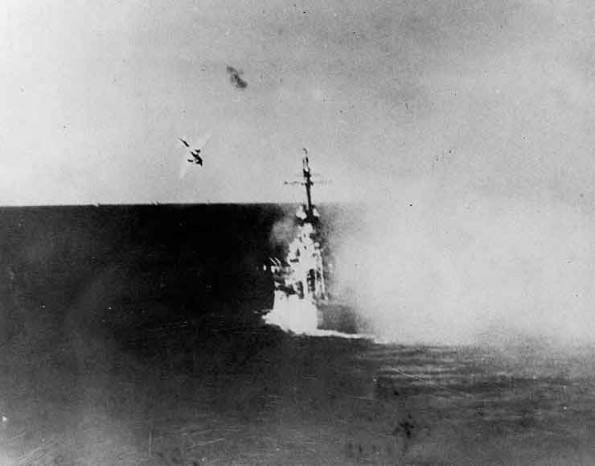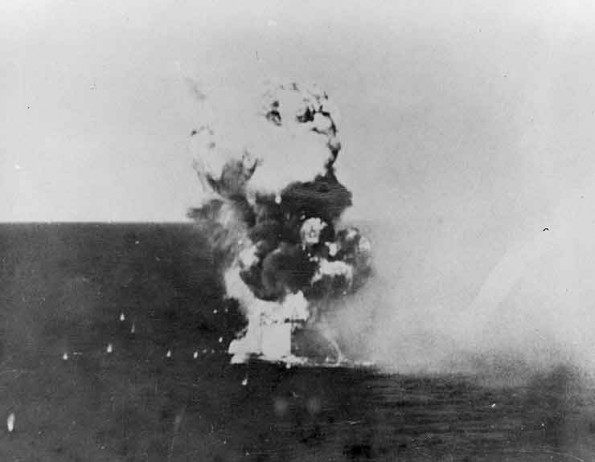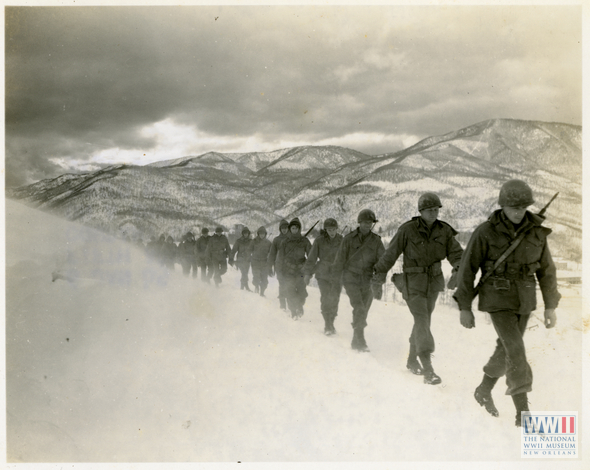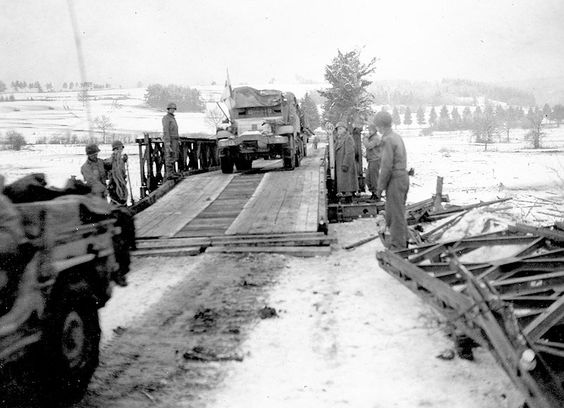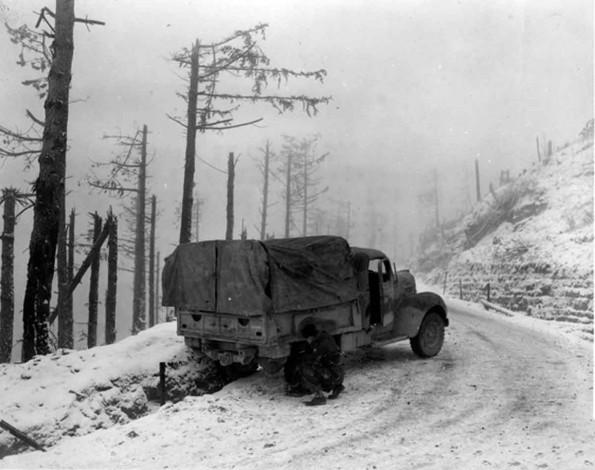Air Operations, CBI
CHINA- 40 14th Air Force P-40s, P-47s, and P-51s attack targets in the Hankow and Wuchang areas.
- 13 58th Very Heavy Bomb Wing B-29s unable to reach their target in Japan attack Nanking.
- 6 B-29s attack various targets of opportunity.
- A 51st Fighter Group P-51 downs a Ki-43 'Oscar' fighter during the early afternoon.
- 4 308th Heavy Bomb Group B-24s attack targets in the Cap St. Jacques area.
Air Operations, East Indies
FEAF aircraft attack various targets throughout the region.
[Air Operations, Europe
RAF BOMBER COMMANDDaylight Ops:
Minor Ops:
- 1 Hudson flies a Resistance operation.
- 482 aircraft of Nos. 1, 4, 6 and 8 Groups are sent to attack Hanau. In the aircraft total are 314 Halifaxes, 154 Lancasters and, 14 Mosquitos. The attack is aimed at that part of Hanau in which an important junction in the German railway system is situated. The local report says that many bombs fell in this area but also states that a large proportion of the bombing was scattered in the south, into the center of Hanau, and to the north, into an area of countryside and villages.
- 4 Halifaxes and 2 Lancasters are lost.
- 147 Lancasters of Nos. 1 and 3 Groups are sent to Neuss. As in Hanau, some of the bombing falls into the railway area but most is scattered over surrounding districts. 1,749 houses, 19 industrial premises and 20 public buildings are destroyed or seriously damaged.
- 1 Lancaster crashes in Belgium.
- 20 Mosquitos are sent to Kassel on a 'spoof' raid and 6 to Castrop-Rauxel, 49 Lancasters lay mines off the Baltic ports, and there are 32 Mosquito patrols and 52 RCM sorties.
- 2 RCM Halifaxes and 2 mine-laying Lancasters are lost.
GERMANY:
- 778 8th Air Force heavy bombers attack rail and other communications targets in western Germany.
- 1 8th Air Force fighter-bomber group attack a marshalling yard.
GERMANY:
- 26 9th Air Division bombers attack Prum.
ITALY:
- XXII TAC P-47s attack rail lines and bridges between Genoa and La Spezia and ships in the harbors at Imperia and Genoa.
Air Operations, Japan
- 28 of 49 58th Very Heavy Bomb Wing B-29s dispatched from Chengtu, China, attack an aircraft factory and city areas at Omura with 91 tons of bombs. 1 B-29 is lost. This mission turns out to be the last over Japan by the XX Bomber Command.
- 2 28th Composite Bomb Group B-24s attack Suribachi in the Kurile Islands.
Air Operations, Philippines
- Despite continuous coverage by FEAF land-based aircraft and Task Force 38 and Task Group 77.4 carrier aircraft, Japanese aircraft, including many kamikazes, mount powerful attacks through the day as US minesweepers and hydrographic vessels arrive in Lingayen Gulf. 16 US Navy surface ships, including the battleship USS New Mexico, and one Australian heavy cruiser are struck by kamikazes during the day. Overall US losses are 167 killed and 507 wounded, and Australian losses are 14 killed and 26 wounded. 1 damaged US destroyer later sinks.
- Task Group 77.4 TBMs and FMs attack pre-invasion targets in the Lingayen Gulf area of Luzon.
- 22 22nd Heavy Bomb Group B-24s attack Clark Field on Luzon.
- 44 XIII Bomber Command B-24s attack Nichols and Nielson Fields on Luzon with 120-pound fragmentation bomb clusters.
- V Bomber Command A-20s and V Fighter Command P-38s attack the Carolina airfield on Negros.
- 5th Air Force aircraft attack numerous targets in the central and southern Philippines.
- In support of the impending invasion of Luzon at Lingayan Gulf, 23 V Bomber Command A-20s and 15 Marine Air Group 12 F4Us attack key bridges at Calumpit, Luzon.
- A total of 59 A-20s, B-25s, and V Fighter Command P-38s attack key bridges at Plaridel, Luzon.
- Carrier-based fighter pilots down 34 Japanese aircraft over the Luzon area between 0715 and 1800 hours.
- VMF-211 F4U downs a Ki-45 'Nick' over Manila Bay at 1535 hours.
- 2 VMF-218 F4Us down an A6M Zero over the Sulu Sea at 1715 hours.
- By the end of the day, Japanese air opposition drops off sharply because of interdiction strikes against Japanese airfields by Task Force 38 aircraft. It is later learned that by the close of operations on January 6, only 35 of the 150 Japanese warplanes based on Luzon on January 1, 1945, can still be flown.
Air Operations, Volcano Islands
- 15 VII Bomber Command B-24s attack Iwo Jima.
- During the night, 9 VII Bomber Command B-24s conduct snooper raids against Iwo Jima.
Allied Planning
Churchill asks Stalin if the Soviet forces can go over to the offensive in Poland to take some of the pressure off the Allied armies in the Bulge. Stalin says that he will arrange for the Red Army plans for its next offensive to be brought forward.
[Eastern Front
The counteroffensive launched by the Germans to open a gap in the Russian forces surrounding the troops cut off in Budapest does not achieve that object, but does lead to the recapture of Esztergom, an important position northwest of the capital.
SOUTHERN SECTORThe 6th Guards Tank Army and 7th Guards Army launch a major attack along the Hron and gain a bridgehead. A German counterattack recaptures Esztergom on the south bank of the Danube. In the Pest bridgehead the 22nd SS Cavalry Division abandons Soroksar. Soviet forces are able to bring the Racecourse airfield under intense arty fire and puts it out of action.
ALLIED DIPLOMACYChurchill inquires if Stalin can bring forward his forthcoming offensive in Poland to draw some of the pressure off the Allied forces in the Ardennes. Stalin orders the Vistula-Oder operation be brought forward from the 20th to the 12th of January.
[Indian Ocean
The 6 remaining U-boats begin returning home.
[Philippines
2 American naval squadrons, ahead of the Luzon invasion fleet, enter the Gulf of Lingayen. The aircraft carriers send up their aircraft against the Japanese airfields, while the naval guns shell the coastal defenses and minesweepers begin to clear the waters of mines. The Japanese react with a violent attack by suicide aircraft, which damage the battleships New Mexico (BB-40) and California (BB-44), the cruisers Louisville (CA-28), already damaged previously, Minneapolis (CA-36) and Columbia (CL-56), 6 destroyers: Newcomb (DD-586), Richard P. Leary (DD-664), Allen M. Sumner (DD-692), Walke (DD-723), O'Brien (DD-725) and Lowry (DD-770), the high-speed minesweeper Southard (DMS-10) and the high-speed transport Brooks (APD-10). Two minesweepers are sunk, Hovey (DMS-11) and Long (DMS-12). There are 608 casualties. Of the 150 aircraft defending Luzon a week ago, there are now only 35 left.
[United States, Planning
10th Army completes its operational planning for Operation ICEBERG, the invasion of Okinawa. After several delays, the date for execution (designated as L-day) is set for April 1 and approved by Adm Nimitz.
The 77th Infantry Division is assigned the mission of seizing the Kerama Islands west of Okinawa prior to the main landings. The 2nd Marine Division will act as a diversionary landing force at the eastern end of Okinawa as the main landing will occur on the western coast in the center of the island. Prelanding fires and operations to destroy Japanese defenses on Okinawa and isolate the landing area from enemy sea and air forces will begin on March 24. On April 1 the III Amphibious Corps will land the 6th and 1st Marine Divisions abreast on the beach landing site north of the town of Hagushi. The 6th Marine Division is to capture Yontan airfield and move the capture the Ishikawa Isthmus. The 1st Marine Division is to capture the Katchin Peninsula. The XIV Corps will land the 7th and 96th Infantry Division abreast to the south of Hagushi. The 7th Infantry Division will capture Kadena airfield and move to the east coast to cut the island in two. The 96th Infantry Division will control the high ground south of the landing beaches, then move south on the eastern coastal road to capture the bridges at Chantan, then move to protect the corp's southern flank. Altogether the Americans will be landing about 116,000 men on L-day. The 27th Infantry Division will be available as a floating reserve one day after the initial landings (L+1).
[Western Front
Units of the VII Corps of the US 1st Army approach Consy and Dochamps, 2nd Arm Div and 84th Inf Div, capture Odeigne and join up with the units of the 3rd Arm Div on the road linking Manhay with Houffalize.
In the 3rd Army sector Bonnerne, defended by the 87th Div, VIII Corps, is attacked by Gen Hasso von Manteuffel's armored group; units of the III Corps, 6th and 35th Divs, suffer heavy losses in counterattacks in the forests northeast of Lutrebois. However, in the Ardennes the withdrawal of Dietrich's 6th SS Panzer Army makes the German position in this sector highly vulnerable. Von Rundstedt, in a memorandum sent to the Oberkommando der Wehrmacht, once more suggests that the German armies be withdrawn east of the Rhine. Once more Hitler refuses. In the southern sector of the front the 45th Div, VI Corps, US 7th Army, continues its efforts to reduce the Bitche salient.
[Images from January 6, 1945
|
|
|
|
|
|
|
|
Supply Planes for Bastogne |
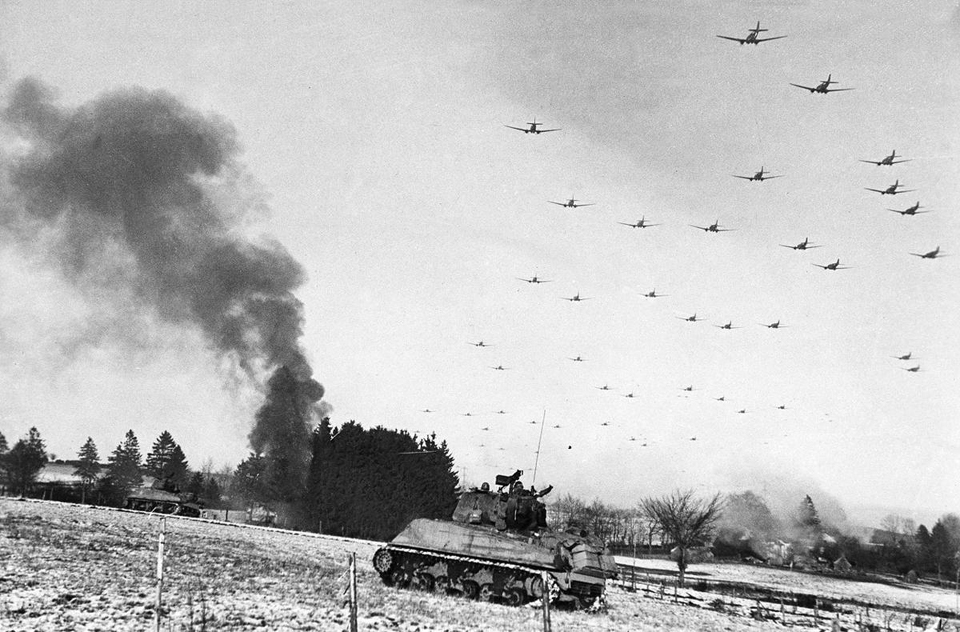 |
